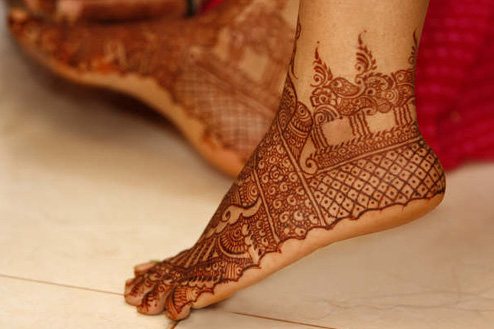Source Google.com.pk
Best Mehndi Designs For Wedding Biography
Mehndi or Mehandi is derived from the Sanskrit word mendhikā.[1] The use of mehndi and turmeric is described in the earliest Hinduism's Vedic ritual books. Haldi (staining oneself with turmeric paste) as well as mehndi are Vedic customs, intended to be a symbolic representation of the outer and the inner sun. Vedic customs are centered around the idea of "awakening the inner light". Traditional Indian designs are of representations of the sun on the palm, which, in this context, is intended to represent the hands and feet.
mehndi also known as henna in the western world is the application of as a temporary form of skin decoration, practiced mainly India and Nepal. Popularized by Indian cinema and entertainment industry Bollywood, the people in Pakistan, Bangladesh and the Maldives as well as by expatriate communities from those countries also use Mehandi. This tradition has spreaded to exist among some Arab Women particularly the Cooperation Council for the Arab States of the Gulf nationals. Mehndi decorations became fashionable in the West in the late 1990s, where they are sometimes called henna tattoos.Mehndi is typically applied during special Hindu occasions like weddings and festivals like Karva Chauth,Vata poornima, Diwali, Bhaidooj and Teej. In Hindu festivals, many women have Henna applied to their hands and feet. It is usually drawn on the palms and feet, where the design will be clearest because the skin on these surfaces naturally contains less of the pigment melanin. Henna was originally used as a form of decoration mainly for Hindu brides. Muslims festivals adopted subsequently during Eid-ul-Fitr and Eid-ul-Adha as well.In the modern age and even due to limited supply of Indian Traditional Mehndi artists, usually people buy ready-made Henna cones, which are ready to use and make painting easy. However, in rural areas in India, women grind fresh henna leaves on grinding stones with added oil, which though not as refined as professionally prepared henna cones, brings much darker colors.The term henna tattoo is figurative, because true tattoos are permanent surgical insertions of pigments underneath the skin, as opposed to pigments resting on the surface as is the case with mehndi.
Best Mehndi Designs For Wedding

Best Mehndi Designs For Wedding 

Best Mehndi Designs For Wedding

Best Mehndi Designs For Wedding

Best Mehndi Designs For Wedding

Best Mehndi Designs For Wedding

Best Mehndi Designs For Wedding

Best Mehndi Designs For Wedding

Best Mehndi Designs For Wedding

Best Mehndi Designs For Wedding

Best Mehndi Designs For Wedding
No comments:
Post a Comment